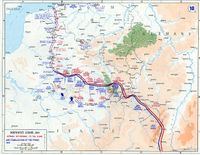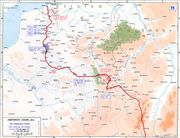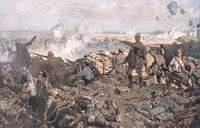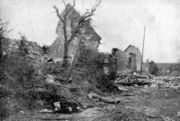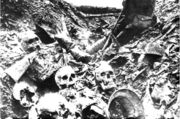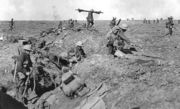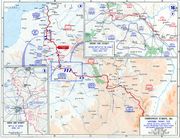Western Front (World War I)
2007 Schools Wikipedia Selection. Related subjects: Military History and War
| Western Front | |||||||
|---|---|---|---|---|---|---|---|
| Part of World War I | |||||||
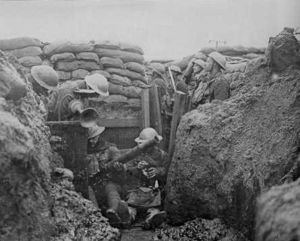 For most of World War I, Allied and German Forces were stalled in trench warfare along the Western Front. |
|||||||
|
|||||||
| Combatants | |||||||
British Empire |
|||||||
| Commanders | |||||||
| No unified command until 1918, then Maréchal Ferdinand Foch | Moltke --> Falkenhayn --> Hindenburg and Ludendorff --> Hindenburg and Groener | ||||||
| Casualties | |||||||
| ~4,800,000 | Unknown | ||||||
| Western Front |
|---|
| Frontiers – Liège – Antwerp – Great Retreat – Race to the Sea – Neuve Chapelle – 2nd Ypres – 2nd Artois – Hill 70 – 3rd Artois – Loos – Verdun – Hulluch – Somme – Arras – Vimy Ridge – 2nd Aisne – Messines – Passchendaele – Cambrai – Lys – 3rd Aisne – Belleau Wood – 2nd Marne – Château-Thierry – Hamel – Hundred Days |
Following the outbreak of the First World War in 1914, the German army opened the Western Front by first invading Luxembourg and Belgium, then gaining military control of important industrial regions in France. The tide of the advance was dramatically turned with the Battle of the Marne. Both sides then dug in along a meandering line of fortified trenches, stretching from the North Sea to the Swiss frontier with France. This line remained essentially unchanged for most of the war.
Between 1915 and 1917 there were several major offensives along this front. The attacks employed massive artillery bombardments and massed infantry advances. However, a combination of entrenchments, machine gun nests, barbed wire, and artillery repeatedly inflicted severe casualties on the attackers and counter attacking defenders. As a result, no significant advances were made.
In an effort to break the deadlock, this front saw the introduction of new military technology, including poison gas, aircraft, and tanks. But it was only after the adoption of improved tactics that some degree of mobility was restored.
In spite of the generally stagnant nature of this front, this theatre would prove decisive. The inexorable advance of the Allied armies in 1918 persuaded the German commanders that defeat was inevitable, and the government was forced to sue for conditions of an armistice.
1914 — German invasion of France and Belgium
At the outbreak of the First World War, the German army executed a modified version of the Schlieffen Plan, designed to quickly attack France through Belgium before turning southwards to encircle the French army on the German border. Armies under German generals Alexander von Kluck and Karl von Bülow attacked Belgium on 4 August 1914. Luxembourg had been occupied without opposition on 2 August. The first battle in Belgium was the Siege of Liège, which lasted from 5 August to 16 August. Liège was well fortified and surprised the German army under von Bülow with its level of resistance. Following the fall of Liège, most of the Belgian army retreated to Antwerp and Namur. Although the German army bypassed Antwerp, it remained a threat to their flank. Another siege followed at Namur, lasting from about the 20 August until 23 August.
The pre-war French offensive plan, Plan XVII, was intended to capture Alsace-Lorraine following the outbreak of hostilities. The main offensive was launched on 14 August with attacks on Saarburg in Lorraine and Mülhausen in Alsace. In keeping with the Schlieffen Plan, the Germans withdrew slowly while inflicting maximum losses upon the French. The French advanced toward the Saar River and attempted to capture Saarburg before being driven back. The French had captured Mülhausen but abandoned it to reinforce the greatly weakened forces in Lorraine.
After marching through Belgium, Luxembourg and the Ardennes forest, the German army advanced, in the latter half of August, into northern France where they met both the French army, under Joseph Joffre, and the initial divisions of the British Expeditionary Force, under Sir John French. A series of engagements known as the Battles of the Frontiers ensued. Key battles included the Battle of Charleroi and the Battle of Mons. A general Allied retreat followed, resulting in more clashes such as the Battle of Le Cateau, the Siege of Maubeuge and the Battle of Guise.
The German army came within 43 miles (70 km) of Paris, but at the First Battle of the Marne ( 6 September – 12 September), French and British troops were able to force a German retreat, ending their advance into France. The German army retreated north of the Aisne River and dug in there, establishing the beginnings of a static western front that was to last for the next three years. Following this German setback, the opposing forces tried to outflank each other in the Race for the Sea, and quickly extended their trench systems from the English Channel to the Swiss frontier.
On the Entente side, the front was occupied by the armies of the allied countries in lengths according to their respective manpower. From the coast in the north, these were Belgium, Portugal, British Empire and France. As the war progressed, however, units were moved to strengthen the efforts of other nations, mainly on the long French front. Here British divisions were fairly prominent and smaller units from Russia and Italy were engaged partially as an expression of political solidarity. For example, British infantry and Italian artillery cooperated with French V Army in the Ardre Valley during the Second Battle of the Marne, in July 1918. At this, later stage in the war, American forces too, were available to be employed in a similar way, though usually in bigger units.
1915 — Stalemate
Between the coast and the Vosges was an outward bulge in the trench line, named the Noyon salient for the captured French town at the maximum point of advance near Compiègne. Joffre's plan of attack for 1915 was to attack this salient on both flanks in order to cut it off. The British would form the northern attack force by pressing eastward in Artois, while the French attacked in Champagne.
On 10 March, as part of what was intended as a larger offensive in the Artois region, the British and Canadian army attacked at Neuve Chapelle in an effort to capture the Aubers Ridge. The assault was made by four divisions along a 2 mile (3 km) front. Preceded by a concentrated bombardment lasting 35 minutes, the initial assault made rapid progress, and the village was captured within four hours. However, the assault slowed because of problems with logistics and communications. The Germans then brought up reserves and counter-attacked, forestalling the attempt to capture the ridge. Since the British had used about one-third of their total supply of artillery shells, General Sir John French blamed the failure on the shortage of shells, despite the success of the initial attack.
Gas warfare
Despite the German plans to maintain the stalemate with the French and British, German commanders planned an offensive at the Belgian town of Ypres, which the British had captured in November 1914 during the First Battle of Ypres. This was in order to divert attention away from major offensives in the Eastern Front while disrupting Franco-British planning and to test a new weapon. After a two-day bombardment, on 22 April, the Germans released chlorine gas onto the battlefield which drifted into the British trenches. The green-yellow cloud asphyxiated the defenders and those in the rear fled in panic creating an undefended four-mile-wide gap in the Allied line. However, the Germans were unprepared for the level of their success and lacked sufficient reserves to exploit the opening. Canadian troops quickly arrived and drove back the German advance. This Second Battle of Ypres marked the first large-scale use of chemical weapons, where 170 tonnes were dropped on the allied lines, resulting in the deaths of 5,000 men within minutes, despite being prohibited by the Hague Convention of 1899.
The gas attack was repeated two days later and caused a three-mile withdrawal of the Franco-British line. But the opportunity had been lost. The success of this attack would not be repeated, as the Allies countered by introducing gas masks and other countermeasures. An example of the success of these measures came a year later, on 27 April, when 25 miles (40 km) to the south of Ypres, at the Battle of Hulluch, the 16th (Irish) Division's troops were able to withstand determined German gas attacks.
Air warfare
This year also saw the introduction of airplanes specifically modified for aerial combat. While planes had already been used in the war for scouting, on April 1 the French pilot Roland Garros became the first to shoot down an enemy plane by using machine guns that fired forward through the propeller blades. This was achieved by crudely reinforcing the blades so bullets which hit them were deflected away.
Several weeks later Garros was forced to land behind German lines. His plane was captured and sent to the Dutch engineer Anthony Fokker, who soon developed a significant improvement, the interrupter gear, in which the machine gun is synchronized with the propellor so that it shoots rounds when the propellor isn't in the line of fire. This advance was quickly ushered into service, in the Fokker E.1 (Eindekker, or monoplane, Mark 1), the first true fighter aircraft; Max Immelmann scored the first kill in an Eindekker 1 August.
This started a back-and-forth arms race, as both sides developed improved weapons, better engines, etc., which would continue until end of the war. It also inaugurated the cult of the ace, the most famous being the Red Baron.
Continued Allied attacks
The final Allied offensive of the spring was fought at Artois, with the goal of trying to capture the Vimy Ridge. The French 10th Army attacked on 9 May after a six-day bombardment and advanced 3 miles (5 km). However, they retreated as they had come into sights of machine gun nests and the German reinforcements fired artillery at the attackers. By 15 May the offensive had ground to a halt.
During autumn of 1915, the " Fokker Scourge" began to have an effect on the battlefront as Allied spotter planes were nearly driven from the skies. These reconnaissance planes were used to direct gunnery and photograph enemy fortifications, but now the Allies were nearly blinded by German fighters.
In September 1915 the Allies launched major offensives with the French attacking at Champagne and the British at Loos. The French had spent the summer preparing for this action, with the British assuming control of more of the front in order to free up French troops. The bombardment, which had been carefully targeted by means of aerial photography, began on 22 September. The main assault was launched on 25 September and, at least at first, made good progress in spite of surviving wire entanglements and machine gun posts. However, forseeing this attack, the Germans had developed defensive lines 2 and 4 miles (3 and 6 km) behind the front lines and were able to defend against the French attack which lasted into November.
Also on 25 September, the British began their assault at Loos, which was meant to supplement the larger Champagne attack. The attack was preceded by a four-day artillery bombardment of 250,000 shells and a release of 5,100 cylinders of chlorine gas. The attack involved two corps in the main assault and two more corps performing diversionary attacks at Ypres. The British suffered heavy losses, especially due to machine gun fire, during the attack and made only limited gains before they ran out of shells. A renewal of the attack on 13 October fared little better. In December, British General John French was replaced by Douglas Haig as commander of the British forces.
1916 — Artillery duels and attrition
The German Chief of Staff, Erich von Falkenhayn, believed that a breakthrough might no longer be possible, and instead focused on forcing a French capitulation by inflicting massive casualties. His new goal was to "bleed France white".
As such, he adopted two new strategies. The first was the use of unrestricted submarine warfare to cut off Allied supplies arriving from overseas. The second would be targeted, high-casualty attacks against the French ground troops. To inflict the maximum possible casualties, he planned to attack a position from which the French could not retreat for reason of both strategic positions and national pride and thus trap the French. The town of Verdun was chosen for this because it was an important stronghold, surrounded by a ring of forts, that lay near the German lines and because it guarded the direct route to Paris. The operation was codenamed Gericht, German for "court", but meant "place of execution".
Falkenhayn limited the size of the front to 3–4 miles (5–7 km) to concentrate their firepower and to prevent a breakthrough from a counteroffensive. He also kept tight control of the main reserve, feeding in just enough troops to keep the battle going. In preparation for their attack, the Germans had amassed a concentration of aircraft near the fortress. In the opening phase, they swept the air space of enemy spotters which allowed the accurate German artillery spotters and bombers to operate without interference. However, by May, the French countered by deploying escadrilles de chasse with superior Nieuport fighters. The tight air space over Verdun turned into an aerial battlefield, and illustrated the value of tactical air superiority, as each side sought to dominate air reconnaissance.
Battle of Verdun
The Battle of Verdun began on 21 February 1916 after a nine-day delay due to snow and blizzards. After a massive eight-hour artillery bombardment, the Germans did not expect much resistance as they slowly advanced on Verdun and its forts. However, heavy French resistance was countered by the introduction of flamethrowers by the Germans. The French lost control of almost all of their forts, including Fort Douaumont. Nonetheless, French reinforcements halted the German advance by 28 February.
The Germans turned their focus to Le Mort Homme to the north from which the French were successfully shelling them. After some of the most intense fighting of the campaign, the hill was taken by the Germans in late May. After a change in French command at Verdun from the defensive-minded Philippe Pétain to the offensive-minded Robert Nivelle the French attempted to re-capture Fort Douaumont on 22 May but were easily repulsed. The Germans captured Fort Vaux on 7 June and, with the aid of the gas phosgene, came within 1,200 yards (1 km) of the last ridge over Verdun before stopping on 23 June.
Over the summer, the French slowly advanced. With the development of the rolling barrage, the French recaptured Fort Vaux in November, and by December 1916 they had pushed the Germans back 1.3 miles (2 km) from Fort Douaumont.
Battle of the Somme
In the spring allied commanders had been concerned about the ability of the French army to withstand the enormous losses at Verdun. The original plans for an attack around the river Somme were modified to let the British make the main effort. This would serve to relieve pressure on the French, as well as the Russians who had also suffered great losses. On 1 July, after a week of heavy rain, British divisions in Picardy launched an attack around the river Somme, supported by five French divisions on their right flank. The attack had been preceded by seven days of heavy artillery bombardment. The experienced French forces were successful in advancing but the British artillery cover had neither blasted away barbed wire, nor destroyed German trenches as effectively as was planned. They suffered the greatest number of casualties (killed, wounded and missing) in a single day in the history of the British army, about 57,000.
Having assessed the air combat over Verdun, the Allies had new aircraft for the attack in the Somme valley. The Verdun lesson learnt, the Allies' tactical aim became the achievement of air superiority and the German planes were, indeed, largely swept from the skies over the Somme. The success of the Allied air offensive caused a reorganization of the German air arm, and both sides began using large formations of aircraft rather than relying on individual combat.
After regrouping, the battle continued throughout July and August, with some success for the British despite the reinforcement of the German lines. By August General Haig had concluded that a breakthrough was unlikely, and instead switched tactics to a series of small unit actions. The effect was to straighten out the front line, which was thought necessary in preparation for a massive artillery bombardment with a major push.
The final phase of the battle of the Somme saw the first use of the tank on the battlefield. The Allies prepared an attack that would involve 13 British and Imperial divisions and four French corps. The attack made early progress, advancing 3,500–4,500 yards (3.2–4.1 km) in places, but the tanks had little effect due to their lack of numbers and mechanical unreliability. The final phase of the battle took place in October and early November, again producing limited gains with heavy loss of life. All told, the Somme battle had made penetrations of only five miles (8 km), and failed to reach the original objectives. The Allies had suffered over 600,000 casualties and the Germans over 460,000, though these figures are disputed.
The Somme led directly to major new developments in infantry organization and tactics; despite the terrible losses of 1 July, some divisions had managed to achieve their objectives with minimal casualties. In examining the reasons behind losses and achievements, the British, and the Colonial contingents, reintroduced the concept of the infantry platoon, following in the footsteps of the French and German armies who were already groping their way towards the use of small tactical units. At the time of the Somme, British senior commanders insisted that the company (120 men) was the smallest unit of maneuver; less than a year later, the section of 10 men would be so.
Hindenburg line
In August 1916 the German leadership along the western front had changed as Falkenhayn resigned and was replaced by Generals Paul von Hindenburg and Erich Ludendorff. The new leaders soon recognized that the battles of Verdun and the Somme had depleted the offensive capabilities of the German army. They decided that the German army in the west would go over to the strategic defensive for most of 1917, while the Central powers would attack elsewhere.
During the Somme battle and through the winter months, the Germans created a prepared defensive position behind a section of their front that would be called the Hindenburg Line. This was intended to shorten the German front, freeing a number of divisions for other duties. This line of fortifications ran from Arras south to St Quentin. British long-range reconnaissance aircraft first spotted the construction of the Hindenburg Line in November 1916.
1917 — British Empire takes the lead
The staged withdrawal to the Hindenburg Line was named Operation Alberich by the Germans. It was begun on 9 February and completed 5 April, leaving behind a devastated territory to be occupied by the Allies. The withdrawal ranged from 6 to 31 miles (10 to 50 km) from the original front lines. This withdrawal negated the French strategy of attacking both flanks of the Noyon salient, as it no longer existed. However, offensive advances by the British continued as the High Command claimed, with some justice, that this withdrawal resulted from the battering the Germans received during the Battle of the Somme.
Meanwhile, on 6 April the United States declared war on Germany. Back in early 1915 following the sinking of the Lusitania, Germany had stopped their unrestricted submarine warfare in the Atlantic because of concerns of drawing the United States into the conflict. With the growing discontent of the German public due to the food shortages, however, the government resumed unrestricted submarine warfare in February 1917. They had calculated that a successful submarine siege of Britain would force that country out of the war within six months, while American forces would take a year to become a serious factor on the western front. The submarine had a brief period of success before Britain resorted to the convoy system, bringing a dramatic reduction in shipping losses.
In April 1917 the British Empire forces launched an attack starting the Battle of Arras. Despite the success of the Canadian Corps and the British 5th Infantry Division, in breaking through German lines at Vimy Ridge, the Allies could not capitalize due to the refusal to provide reinforcements to the region.
During the winter of 1916–17, German air tactics had been improved, a fighter training school was opened at Valenciennes and better aircraft with twin guns were introduced. The result was near disastrous losses for Allied air power, particularly for the British, who were struggling with outmoded aircraft, poor training and weak tactics. As a result the Allied air successes over the Somme would not be repeated, and heavy losses were inflicted by the Germans. During their attack at Arras, the British lost 316 air crews compared to 114 lost by the Germans. This became known to the RFC as Bloody April.
French morale
The same month, French General Robert Nivelle ordered a new offensive against the German trenches, promising that it would be a war-winner. The attack, dubbed the Nivelle Offensive (also known as Chemin des Dames, after the area where the offensive took place), would be 1.2 million men strong, to be preceded by a week-long artillery bombardment and accompanied by tanks. However, the operation proceeded poorly as the French troops had to negotiate rough, upward-sloping terrain. In addition, detailed planning had been dislocated by the voluntary German withdrawal to the Hindenburg Line, secrecy had been compromised, and German planes gained control of the sky making reconnaissance difficult. This allowed the creeping barrage to move too far ahead of the advancing troops. Within a week 100,000 French troops were dead. Despite the heavy casualties and his promise to halt the offensive if it did not produce a breakthrough, Nivelle ordered the attack continued into May.
On 3 May the weary French 2nd Colonial Division, veterans of the Battle of Verdun, refused their orders, arriving drunk and without their weapons. Their officers lacked the means to punish an entire division, and harsh measures were not implemented. The mutinies afflicted 54 French divisions and saw 20,000 men desert. Instead, appeals to patriotism and duty encouraged the soldiers to return to defend their trenches, although they refused to participate in further offensive action. By 15 May Nivelle was removed from command, replaced by General Henri Philippe Pétain, who suspended large-scale attacks. The French would go on the defensive for the next year, leaving the burden of attack to Britain and her Empire.
British offensives, American troops arrive
On 7 June a British offensive was launched on Messines ridge, south of Ypres, to retake the ground lost in the First Battle of Ypres in 1914. Since 1915 engineers had been digging tunnels under the ridge, and 455 tonnes (1,000,000 lb) of ammonal explosives had been planted in 21 mines under the enemy lines. Following four days of heavy bombardment, the explosives in 19 of these mines were set off resulting in the deaths of 10,000 Germans. The offensive that followed again relied on heavy bombardment, but these failed to dislodge the Germans. The offensive, though initially stunningly successful, faltered due to the flooded, muddy ground, and both sides suffered heavy casualties.
On 11 July 1917 during this battle, the Germans introduced a new weapon into the war when they fired gas shells delivered by artillery. The limited size of an artillery shell required that a more potent gas be deployed, and so the Germans employed mustard gas, a powerful blistering agent. The artillery deployment allowed heavy concentrations of the gas to be used on selected targets. Mustard gas was also a persistent agent, which could linger for up to several days at a site, an additional demoralizing factor for their opponents. Along with phosgene, gas would be used lavishly by both German and Allied forces in later battles, as the Allies also began to increase production of gas for chemical warfare.
On 25 June the first U.S. troops began to arrive in France, forming the American Expeditionary Force. However, the American units did not enter the trenches in divisional strength until October. The incoming troops required training and equipment before they could join in the effort, and for several months American units were relegated to support efforts. In spite of this, however, their presence provided a much-needed boost to Allied morale.
Beginning in late July and continuing into October the struggle around Ypres was renewed with the Battle of Passchendaele (technically the Third Battle of Ypres, of which Passchendaele was the final phase). The battle had the original aim of pushing through the German lines and threatening the submarine bases on the Belgian coast, but was later restricted to advancing the British Army onto higher (and drier) ground around Ypres, no longer constantly under observation from German artillery. Canadian veterans from the Battle of Vimy Ridge and the Battle of Hill 70 joined the depleted ANZAC and British forces and took the village of Passchendaele on 30 October despite extremely heavy rain and casualties (suffering around 16,000 casualties). Again the offensive produced large numbers of casualties for relatively little gain, though the British made small but inexorable gains during periods of drier weather. The ground was generally muddy and pocketed by shell craters, making supply missions and further advancement very difficult. Both sides lost a combined total of over a half million men during this offensive. The battle has become a byword for bloody and futile slaughter among British historians, whilst the Germans called Passchendaele "the greatest martyrdom of the War". It is one of the two battles (the other is the Battle of the Somme) which have done most to earn British Commander in Chief Sir Douglas Haig his controversial reputation.
Battle of Cambrai
On 20 November the British launched the first massed tank attack during the Battle of Cambrai. The British attacked with 324 tanks, with one-third held in reserve, and twelve divisions, against two German divisions. To maintain surprise, there was no preparatory bombardment; only a curtain of smoke was laid down before the tanks. The machines carried fascines on their fronts to bridge trenches and 4 m-wide (12-foot-wide) German tank traps. Except for the 51st (Highland) Division, who did not advance in columns behind the tanks but as a line across the field, the initial attack was a success for the British. The British forces penetrated further in six hours than had been achieved at the Third Ypres in four months, and at a cost of only 4,000 British casualties.
However, the advance produced an awkward salient and a surprise German counteroffensive on 30 November drove the British back to their starting lines. Despite the reversal, the attack had been seen as a success by the Allies as it proved that tanks could overcome trench defences. The battle had also seen the first massed use of German stosstruppen on the western front, which used infantry infiltration tactics to successfully penetrate the allied lines.
1918 — Final offensives
Following the successful Allied attack and penetration of the German defences at Cambrai, Ludendorff determined that the only opportunity for German victory now lay in a decisive attack along the western front during the spring, before American manpower became a significant presence. On 3 March 1918, the Treaty of Brest-Litovsk was signed, and Russia withdrew from the war. This would now have a dramatic effect on the conflict as 44 divisions were now released from Eastern Front for deployment to the west. This would give them an advantage of 192 divisions to the Allied 173 divisions, which allowed Germany to pull veteran units from the line and retrain them as sturmtruppen. In contrast, the Allies still lacked a unified command and suffered from morale and manpower problems: the British and French armies were sorely depleted, and American troops had not yet transitioned into a combat role.
Ludendorff's strategy would be to launch a massive offensive against the British designed to separate them from the French and drive them back to the channel ports. The attack would combine the new storm troop tactics with ground attack aircraft and a carefully planned artillery barrage that would include gas attacks.
German spring offensives
Operation Michael, the first of the German spring offensives, very nearly succeeded in driving the French and British armies apart, advancing about 40 miles (65 km) during the first eight days and moving the front lines more than 60 miles (100 km) west, within shelling distance of Paris for the first time since 1914.
As a result of the battle, the two Allies finally agreed on a unified system of command. General Ferdinand Foch was appointed commander of all Allied forces in France. The unified Allies were now better able to respond to each of the German drives, and the offensive turned into a battle of attrition.
In May the American divisions also began to play an increasing role, winning their first victory at Cantigny. By the summer, 300,000 American soldiers were arriving every month. A total of 2.1 million American troops would be deployed on this front before the war came to an end. The rapidly increasing American presence served as a counter for the large numbers of redeployed German forces.
Final allied offensives
In July Foch initiated a planned offensive against the Marne salient produced during the German attacks. This attack was successful in eliminating the salient by August. A second major offensive was launched two days after the first ended at Amiens to the north. This attack would include Franco-British forces, but was spearheaded by Australian and Canadian troops along with a mass of 600 tanks and supported by 800 aircraft. The assault proved highly successful, leading Hindenburg to name 8 August as the "Black Day of the German Army".
The German army's manpower had been severely depleted after four years of war, and its economy and society were under great internal strain. The Hundred Days Offensive beginning in August proved the final straw, and following this string of military defeats, German troops began to surrender in large numbers. As the Allied forces broke the German lines at great cost, the German Imperial Monarchy collapsed, and the two near-dictatorial commanders of the army, Hindenburg and Ludendorff, stepped aside. Battles were still raging when the German Revolution put a new government in power that quickly signed an armistice which stopped all fighting on the Western Front on Armistice Day ( 11 November 1918).
Consequences
The war along the western front led the German government and its allies to sue for peace in spite of German success elsewhere. As a result the terms of the peace were dictated by France, Britain and the United States, during the 1919 Paris Peace Conference. The result was the Treaty of Versailles, signed in June 1919. The original terms of the treaty would cripple Germany as an economic and military power, so the military delegation refused to sign. Instead, it was agreed to by a delegation of the new German government.
The Versailles treaty returned the border provinces of Alsace-Lorraine to France, thus limiting coal required by German industry. It also severely limited the German armed forces by restricting the size of the army to 100,000 and disallowing a navy or air force. The navy was sailed to Scapa Flow under the terms of surrender but was later scuttled as an act of defiance by its crews. The west bank of the Rhine would be demilitarized and the Kiel Canal opened to international traffic. The treaties also drastically reshaped Eastern Europe.
| Battle | Year | Allies | German |
|---|---|---|---|
| 1st Marne | 1914 | 263,000 | 250,000 |
| Verdun | 1916 | 377,000+ | 336,000+ |
| Somme | 1916 | 623,907 | 465,000+ |
| 2nd Aisne | 1917 | 187,000 | 168,000 |
| Michael | 1918 | 255,000 | 239,000 |
Germany in 1919 was bankrupt, the people living in a state of semi-starvation, and having no commerce with the remainder of the world. The allies occupied the Rhine cities of Cologne, Koblenz and Mainz, with restoration dependent on payment of reparations. Among the German populace, the myth arose that the German army had not been defeated, which would later be exploited by Nazi party propaganda to partly justify the overthrow of the Weimar Republic. (See Dolchstoßlegende.)
France suffered heavy damage in the war. In addition to loss of life, the industrial north-east of the country had been devastated by the war. (Once it was clear that Germany was going to lose, Ludendorff had ordered the destruction of the mines in France and Belgium. His goal was to cripple the industries of Germany's main European rival.) France would later build a massive series of fortifications along the German border known as the Maginot Line, banking on these structures to prevent future German aggression.
The war in the trenches left a generation of maimed soldiers and war widows. The unprecedented butchery had a lasting effect on popular attitudes toward war, resulting in an Allied reluctance to pursue an aggressive policy toward Adolf Hitler (himself a decorated veteran of the war). The repercussions of that struggle are still being felt to this day.
Dramatizations
- All Quiet on the Western Front, Erich Maria Remarque (1929 novel)
- All Quiet on the Western Front (1930 film)
- All Quiet on the Western Front (1979 TV film)
- The Big Parade (1925 film)
- Birdsong, Sebastian Faulks (1994 novel)
- Blackadder Goes Forth (1989 TV series)
- " The Dawn Patrol"" (1930 and 1938 film)
- " The General", C.S. Forester (1932 novel)
- Generals Die in Bed, Charles Yale Harrison (1936 novel)
- Johnny Got His Gun (1971 film)
- Legends of the Fall (1994 film)
- The Lost Battalion (1919 film, 2001 TV remake)
- Passchendaele (2006 film)
- Paths of Glory (1957 film)
- The Rage of Angels, Alan Fisher (1997 novel)
- " Sergeant York" (1940 film)
- The Wars (1983 film)
- What Price Glory (1926 and 1952 films)
- Wings (1927 film)
- The Young Indiana Jones Chronicles (1992-1996 TV series)
